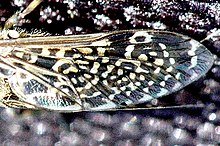Rain brake
| Rain brake | ||||||||||||
|---|---|---|---|---|---|---|---|---|---|---|---|---|

Rainfly ( Haematopota pluvialis ) |
||||||||||||
| Systematics | ||||||||||||
|
||||||||||||
| Scientific name | ||||||||||||
| Haematopota pluvialis | ||||||||||||
| ( Linnaeus , 1758) |

The rainfly ( Haematopota pluvialis ), popularly also known as the rainbow fly, the blind fly, the thunderstorm fly and the rotten fly, is a species of fly from the family of the horseflies (Tabanidae).
features
Rain brakes reach a body size of 8 to 12 millimeters. The slim body has a dark brown to gray color, the thorax has dark longitudinal stripes. The conspicuously large compound eyes are clearly separated in the females, but in the males they meet almost on the entire inside. They are colored burgundy, but in the females they are dominated by three serpentine bands colored in rainbow colors. The males only have one such band on the lower outside of the eyes. The wings are milky and have a white to grayish marbling. In the resting position, they are placed like a roof over the abdomen . The female has a strong, short proboscis, which is largely regressed in the male. The antennae are multi-parted and stretched forward like a horn.
Occurrence and distribution
The rain brake occurs in the entire Palearctic region up to an altitude of about 2000 m. It is considered the most common horsefly species in Europe and is found mainly in swamps and wet meadows as well as near forests, but not within forests.
Way of life
The females suckle blood from mammals , while the males feed on nectar and vegetable juices. Like most horseflies, female horseflies need a meal of blood for egg development. The eggs are laid in layered egg packages on plants near the water. The larvae live in water or damp soil and obtain the necessary oxygen through skin respiration . They feed on detritus and carrion.
The flight time of the species ranges from May to October. People are often bitten, especially in midsummer. Unlike, for example, mosquitoes or the gadfly , the gadfly approaches almost silently. The sting follows as with most blood-sucking insects a wheal and a strong itch . Diseases such as anthrax or Weil's disease can also be transmitted.
Origin of name
The names rain brake and thunderstorm brake refer to the particularly high activity and willingness to pierce Haematopota pluvialis shortly before and when it rains. The origin of the name blind fly is not completely clear. In the literature there is an explanation that the name refers to the clouded wings and that the name is based on the fact that the rainflies hardly interfere when searching for food and can therefore usually be easily killed without attempting to escape, as if they were blind would. Occasionally, it is also said that the name comes from the earlier popular belief that a female's bite can blind a person . In addition to the rainfly, however, the gadfly in general or the common blind fly ( Chrysops caecutiens ) is sometimes referred to as the blind fly.
The name Rainbow Brake goes back to the multi-faceted eyes of the rain brake that shimmer in all rainbow colors.
literature
- HW Smolik: Plants and animals of our homeland . Neumann & Göbel Verlags-GmbH, Cologne 1985
- Helgard Reichholf-Riehm: Insects . Mosaik-Verlag, Munich 2000, ISBN 3-572-01088-8
- Heiko Bellmann : Life in the brook and pond . Mosaik-Verlag, Munich 1998
Individual evidence
- ↑ Quälgeist flies on moisture ( Memento of July 3, 2008 in the Internet Archive ), evidence of the name Faulstich.
- ↑ Vermin: Regenbremse ( Memento from July 10, 2009 in the Internet Archive )
- ^ [1] Proof of the origin of the name Regenbremse.
- ↑ Werner Jacobs, Maximilian Renner, Klaus Honomichl : Biology and ecology of insects . 3. Edition. Spectrum Akademischer Verlag, Stuttgart 1998, ISBN 3-8274-0799-0 .
- ↑ Heiko Bellmann: The new cosmos insect guide . Franckh-Kosmos Verlag, Stuttgart 1999, ISBN 3-440-07682-2 .


